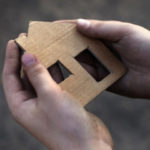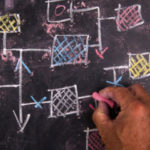In the December 2011 issue of Convene, we introduced you to Appreciative Inquiry (AI), the change-leadership methodology pioneered by David Cooperrider — and to Cooper-rider’s vision for using this strengths-based approach to revolutionize the meetings industry.
“We are on the eve of the meetings industry’s finest hour,” Cooperrider — a professor of social entrepreneurship at the Weatherhead School of Management at Case Western Reserve University — told Susan Sarfati, CAE, in that interview. But, he added, we can’t get there without changing the way conferences are designed. “Why,” he asked, “would we bring thousands of participants together and not engage their strategic and creative minds and imagination for some significant advancement of opportunities for their organization?”
Instead of the traditional conference format of downloading information (Conference 1.0), or a version of that with some dialogue and networking sprinkled in (Conference 2.0), Cooperrider proposed that planners embrace a new model, Conference 3.0, for their large-group meetings — tapping into all the attendees’ talents with a process for them to work collectively on tasks with strategic and creative value. Meeting takeaways — actionable steps to move an industry or field forward — would then be the culmination of this effort, rather than highlights of education sessions.
Cooperrider’s invitation resonated with Convene reader Robert S. Collier, president and CEO of the Council of Michigan Foundations (CMF), who promptly began to overhaul CMF’s upcoming 40th Annual Conference. “When I read the article,” Collier told Convene, “I said, ‘This is exactly what we should be doing — what was suggested in this article about creating a Conference 3.0 experience — because I’ve trained my staff on Appreciative Inquiry.’”
After hearing from Collier, we decided to delve a little deeper into the Conference 3.0 model. First, we asked Collier to describe how he wove AI methodology into his conference. And then we went back to the source, and asked Cooperrider to walk us through a few successful AI Summits he spearheaded. Here, in his own words, he shares how two such events yielded powerful results: a three-day summit for 250 leaders in the dairy industry — farmers, processors, retailers, distributors, students, NGOs, academics, consultants, and others — on industry sustainability, held in 2008; and Sustainable Cleveland 2019: Building an Economic Engine to Empower a Green City on a Blue Lake, which began in 2009 with more than 700 business leaders and civic entrepreneurs, and is now held annually. He starts us off with Pre-Summit Work.
Pre-Summit Work
In an Appreciative Inquiry Summit, the pre-summit steering committee comes together typically for a day-and-a-half to two days of design work. They have three or four major things that they need to accomplish.
First, they need to really articulate what is the collective-action task. Secondly, relative to that task, who are all the stakeholders that we want to make sure are in the room? They map the stakeholder groups and give proportionate numbers to those. So if we want young people to be part of the sustainable dairy-industry movement, what percentage of the convention should be young people in order to accomplish our task? How many and what proportions of each stakeholder do we need to have to really advance this task?
And then the third thing they do is develop the pre-summit research. Sometimes they will do Appreciative Inquiry analysis and interviews throughout the industry to lift up the very best of the best, all of the innovations and all of the best practices so that you come into the summit with a database of strengths that really can help build the vision of the future – so the summit is not just an emergent process, but we come into it with some real business and economic insight.
Another task is to come up with the pre-summit momentum building. How do we ensure that we fill the room with the right stakeholders? And then how do we communicate in a way that builds the excitement and momentum? Sometimes groups will do a webcast ahead of time, to prepare people.
Finally, the group starts designing the post-summit follow-through designs even before the summit takes place, so that already there is really good extensive thinking about how we move forward. In the dairy-industry summit, in order to create a sustainable dairy industry for America, in post-summit work they created a new innovation corporation to do the fundraising for a lot of these innovations. And it is quite amazing. I think they raised over $100 million in funds to foster the innovations, like ways of taking methane and turning it into natural-gas pipelines.
An AI Summit is a meeting where everyone is engaged as designers, sharing leadership and taking ownership for making the future of some big-league opportunity successful. The meeting appears bold at first, but is based on a simple notion: When it comes to enterprise innovation and integration, there is nothing that brings out the best in human systems — faster, more consistently, and more effectively — than the power of “the whole.”
Day One: Discovery
With the dairy-industry summit, instead of just a typical association kind of meeting, we created a real action-oriented focus around creating a sustainable dairy industry. The first day’s morning session was on the discovery of all the assets, strengths, and innovations bubbling up in the sustainability domain — ways in which wind energy was powering the dairy farms, transportation costs were being cut in half through better logistics; all the ways in which the industry was going greener.
This first phase of the convention is the Discovery Phase, where you craft very powerful questions to elevate the true, good, better, the possible — all the strengths in the system already there. I call it mapping the positive core of that system. Typically, we have people just turn to the person next to them and do an Appreciative Inquiry interview — again, focused on elevating all of the stories of strength, innovation, capacity, and potential.
Then the participants are organized into groups at tables — usually groups of eight that are very maximum-mix groups. We had farmers at the table, scientists, and agricultural schools, universities, government leaders and regulators — we had the whole system in the room. So each table was a composite, a microcosm of that whole system.
The Discovery Phase is followed by the afternoon session, which can be more of a typical conference format — breakout groups, keynoter, and panels to present the cutting-edge, frontier information that that community is coming for.
Day Two: Dream
The next day, we start the morning session with what we call the Dream Phase, where we have that whole system of people collectively imagine the possible and the preferred future, at their tables, again in maximum-mix kind of groups. But it is not just utopian dreaming. It is dreaming with our feet on the ground. It is kind of a grounded visioning process, where we look at what our history together has prepared us for, what the world is calling for, and then we ask people to step into that future — to think 10 to 20 years out. Small innovations and much bolder and larger innovations have occurred, and the industry became exactly as they would like to see it. What is new? What is better? What is different? What has changed? And how did it get there?
There are lots of differences, obviously, in these very diverse groups. But we honor the differences, and then we search to really put this stake in the ground around our common ground. We use creative tools where participants actually take part in a skit or a day in the life of the future. Or, if they choose to do a more conventional panel, they can do that as well. But they then step into the future and share that vision as clearly as they can. In the case of the dairy-industry summit, we saw visions of completely green renewable energy powering all the farms in the United States. There were visions of new agricultural methodologies that led to sustainable soil and sustainable farming methods. There were new advertising and marketing programs that helped consumers think in more ecologically advanced terms.
Each group looks at and identifies that long-range future that they most want to create. It is a very exciting phase. And then we can go into a typical conference mode in the afternoon, with workshops, breakout groups, panels, and keynote speakers.
Day Three: Design
This is the Design Phase, where overnight the steering committee, who had designed the summit, lift out — from all the dreams collected from the tables, notes, and presentations of people’s images of the future — the most positive, valued, and dynamic images of what people wanted to work toward. And then they look for common ground. They list the concrete ideas, and maybe anywhere between a dozen to 25 opportunity areas start emerging.
At Sustainable Cleveland, after the Dream Phase, you could see that there were real opportunity areas: offshore wind energy, taking local foreclosed lands and turning those into urban farms, creating green urban spaces, creating renewable energy power for automobiles and city vehicles. In this case, we came up with about 20 concrete areas that some creative group could start designing. We use design-thinking tools like rapid prototyping, so that the groups come out of their design work with more than just words on a piece of paper, more like an action plan. One group came up with the business-plan design and the five stages to establish offshore wind energy — where they would develop a northeast Ohio wind-energy corporation that would go after government grants, and so on.
At this stage, they actually prototype and build models or storyboards of those initiatives. We are learning a lot from design firms and design thinkers — people like architects — on how important it is to create a tangible representation of the opportunity area. What happens is that gives a tremendous momentum then for coming out of a summit with enough concreteness that the odds of following up go way up.
So the people in Cleveland, coming together to design this Green City on a Blue Lake — one group designed kind of the constitution for that. Or the dairy industry, one group designed the constitution, the principles, behind a sustainable dairy.
These folks felt very much like the early designers of our country in the sense that they knew that they were collaborating on something that would have reverberations for decades, perhaps centuries.
We have not had a lot of experience in harnessing the universe of strengths in a whole industry or a whole association or a whole city. That’s what this Appreciative Inquiry approach allows, because it is so positive, so focused on assets and solutions. It allows for the very best in human beings to come out quickly. And it allows for large groups to come to closure with collective-action opportunities that are in many cases truly astonishing. It really speeds up the progress that whole industries or associations can take.
In the final stage in the summit, the Deployment Stage or Destiny Phase, groups are invited to continue working on their collective action area and also are invited to think of who else needs to be involved and where else these innovative projects could partner with coming out of the summit. For example, one person from each of the groups becomes part of a council that guides this forward. And so, if you have 20 working groups, you have then 20 people on this leadership council whose job it is to really help nurture the synergies between the groups, help speed the flow of success stories and innovations, and to help the groups remove obstacles. And very often what emerges is the recommendation that we should do this again next year or every other year to keep the momentum flowing.
People want more out of their conferences and conventions now. They do not want just some good networking. They want action and they want to be part of something bigger than themselves.
There’s tremendous opportunity for associations and industries to be able to help propel whole industries or whole associations forward. As human beings, our sense of purpose goes up when we are given these collective-action opportunities to have legacy impact.
More Resources
Learn more about the joint conference of the Council on Michigan Foundations and the Michigan Nonprofit Association.
For more on the Council of Michigan Foundations, visit michiganfoundations.org.
‘Forced Out of Our Traditional Conference Box’
The website welcome page for the joint Council of Michigan Foundations (CMF) 40th Annual Conference and Michigan Nonprofit Association (MNA) Super Conference, held Oct. 8-9 in Dearborn, promised attendees a different experience. And not just because the two organizations had joined forces to host “Strong Partners for a Strong Michigan” -bringing together more than 1,000 nonprofit leaders from grantmaker and grantseeker organizations. “You will be invited to be a builder,” the welcome message read, “to help construct the 2013 road map for a stronger Michigan nonprofit sector.”
CMF President & CEO Robert S. Collier’s impetus to make this a highly participatory event came from reading Convene’s interview with Appreciative Inquiry (AI) pioneer David Cooperrider. Collier was already well-versed in AI and had trained his staff to use this leadership approach, so it seemed logical to use it as a framework for the conference.
The CMF/MNA joint 2012 annual conference began with six speakers presenting rapid-fire five-minute “Tool Talks,” each addressing a different theme beginning with the letter “I” – investment, impact, inclusion, information, involvement, and innovation — to help ignite attendees’ thinking (see “The I’s Have It,” at right). The goal was for participants to build “a roadmap” around those six themes, Collier said. Approximately 700 people were broken into 12 groups; each group had two facilitators – one from MNA and one from CMF. “We had two discussion groups on each theme,” Collier said. “And first, they did two discussion sessions. Monday afternoon, right after the plenaries, their charge was to identify five strengths, three opportunities, and a vision around that ‘I’ word, whether it be innovation, impact, etc. And then during the same discussion time, the next day on Tuesday, they focused on and each came up with three action steps – so we now had 36 recommended action steps. And out of that group, we identified one for each that we talked about at the closing plenary.”
At the closing plenary, a graphic illustration of the six I’s was presented for the group (above), “and it said, based on what you all have done in these construction-zone discussions for the last two days, we’ve now given some action steps which we are committed to going forward with – and here are some examples,” Collier said. “So we were able to give them a good teaser.” After the conference, Collier and his team wrapped up the details with the facilitators to “put all of this up on our 2013 roadmap website” for the nonprofit sector for Michigan.
How was the AI approach received? “I have no qualms about saying it was a great strategy for us to introduce,” Collier said. “I had people say to me that they’ve been coming to our conference for years hearing good speakers, getting to network. But this was the first time they’d ever really been asked to participate in building something for the future. It was really cool to watch this. I mean, clearly one of the key issues is making sure the facilitators are well-prepared, understand Appreciative Inquiry, and also understand their role.”
While he conceded that “not all facilitators are equal,” he has found the feedback to be overwhelmingly positive. Several attendees made a similar comment: “You forced us out of our traditional conference box, Collier.”
The I’s Have It
The six TED-style speakers at the CMF/MNA 2012 joint conference and their themes, from the conference website and as described by CMF’s Robert Collier:
Investment
Peter Berliner, managing director of Mission Investors Exchange, will describe investments made by foundations and other mission-based organizations to further their philanthropic goals. How can we best maximize the opportunities of the social economy?
Impact
John Kania, managing director of FSG and co-author of Collective Impact and Channeling Change, will engage us on measurement. How do we know our nonprofit organizations and foundations are making a difference?
Inclusion
Dr. Lynn Wooten, associate dean, Ross School of Business, University of Michigan, will enlighten us on the growth promise of equity and inclusiveness. How do we ensure that all Michiganders are at the table?
Information
Lucy Bernholz, futurist and author of Blueprint 2012: Navigating the New Social Economy, will energize us on the role of data and communications in this rapidly changing environment. How do we collectively use data and social media to best tell the story for our roadmap?
Involvement
Breannah Alexander, commissioner, Michigan Community Services Commission, will ignite our thinking on engaging all Michiganders in service — especially our youth. At a time of great change, how do we make sure our youth are not sitting on the sidelines?
Innovation
Toby Barlow, chief creative officer, Team Detroit, moved from Brooklyn to Detroit because it is “a vast enormous canvas where anything imaginable can be accomplished.” How can we use this spirit of innovation to strengthen our partnerships to benefit all of Michigan?
Test Time
Here’s how to earn your CEU hour. Once you finish reading this CMP Series article, read and view the following material:
- The original Convene interview with David Cooperrider on using Appreciative Inquiry at conferences.
- Download a PDF of the National Grid Appreciative Inquiry Summit workbook, which includes the mission statement, program, and process for this summit, which took place in London this past September.
- A short video of David Cooperrider being interviewed after presenting a session at the Convene Forum, held Oct. 28-30,2012, in Nashville.
To earn one hour of CEU credit, visit pcma.org/convene-cmp-
To earn additional credit, you can take more more tests in our series here: pcma.co/ConveneCEUs
The Certified Meeting Professional (CMP) is a registered trademark of the Convention Industry Council.




